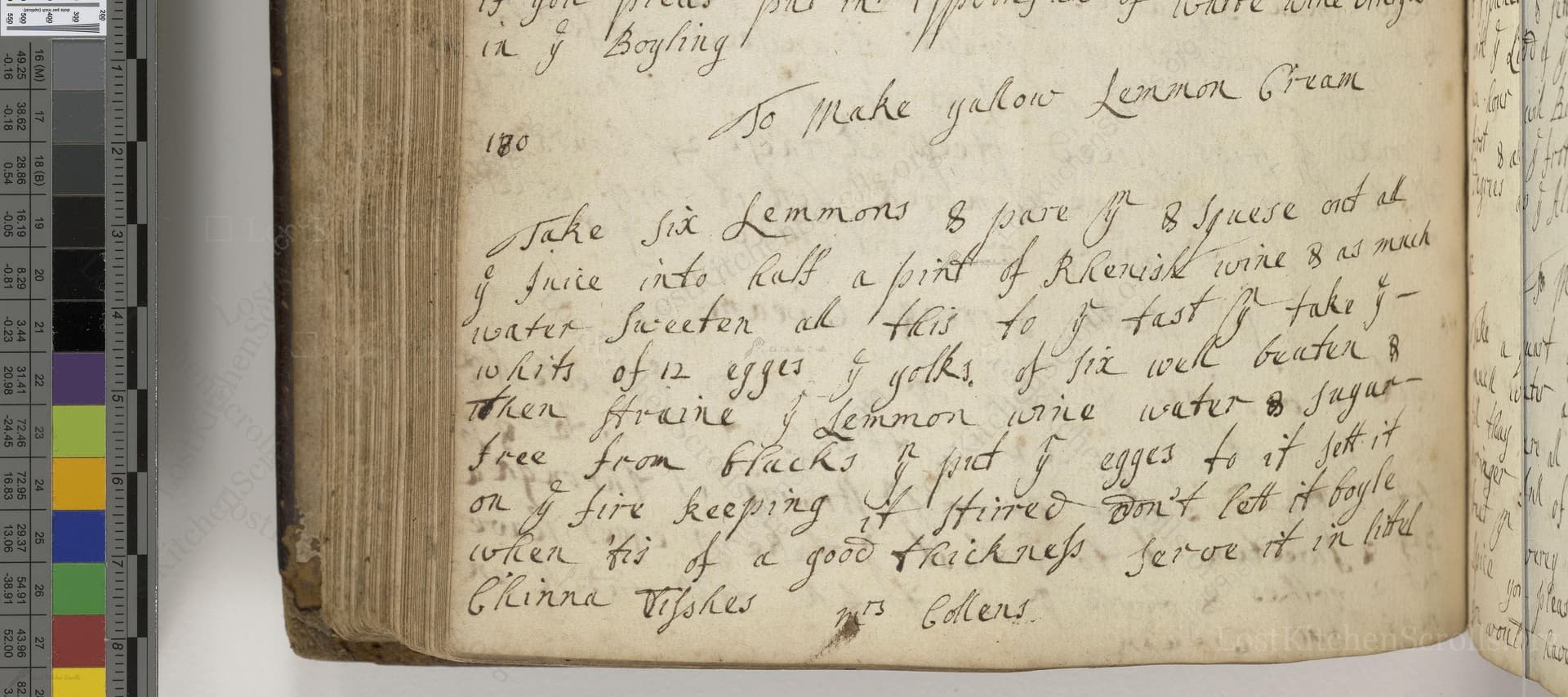To Make Yellow Lemmon Cream
From the treasured pages of Receipt book
Unknown Author

To Make Yellow Lemmon Cream
"Take six Lemmons & pare ye & Squeze out all ye Juice into half a pint of Rhenish wine & as much water sweeten all this to ye tast & take ye whits of 12 egges & yolks of six well beaten & then straine ye Lemmon wine water & sugar free from blacks & put ye egges to it sett it on ye fire keeping it stired don't let it boyle when 'tis of a good thickness serve it in littel Chinna Dishes mrs Collens."
Note on the Original Text
This recipe, like many from the period, is written in a narrative, unmeasured format, assuming the cook’s familiarity with ingredients and techniques. Spelling is idiosyncratic ('whits' for 'whites', 'boyle' for 'boil', 'eggse' for 'eggs'), and there’s little punctuation. Quantities are sometimes vague, offering latitude to experienced cooks, while terms like 'sweeten to tast' underscore the expectation of personal judgment. The instruction to strain 'free from blacks' refers to removing pips, zest fragments, or any impurities, and the caution not to let the mixture boil highlights the reliance on gentle hand control, as precise heat regulation was not possible in historic kitchens.

Title
Receipt book (1700)
You can also click the book image above to peruse the original tome
Writer
Unknown
Era
1700
Publisher
Unknown
Background
Step back into the bustling kitchens of the 18th century, where this delightful collection offers a taste of bygone feasts, whimsical recipes, and the art of refined entertaining.
Kindly made available by
Folger Shakespeare Library
This recipe comes from early 18th-century England, a time when cookery manuscripts circulated among gentry households, frequently in handwritten collections by and for women cooks. Citrus fruits like lemons were prized luxury imports, associated with refinement and fashionable entertainments. Rhenish wine (from the Rhineland region of Germany) was a highly regarded imported white wine, indicative of the trade links and culinary tastes of the upper classes. Egg-based lemon creams like this sit at the intersection of custard and syllabub recipes, showcasing the era's fondness for richly-accented, tangy-sweet desserts served in small, elegant Chinese porcelain (chinna) dishes—a status symbol in themselves.

In the early 1700s, cooks would have used earthenware or pewter bowls for beating eggs, a knife or small paring tool for peeling lemons, and linen cloths for straining liquids. Mixing was done by hand with birch or wooden whisks. Cooking was done over open hearths or on a charcoal chafing dish, with constant stirring by a wooden spoon to prevent scorching or curdling. The finished cream would be poured into delicate porcelain dishes for serving.
Prep Time
15 mins
Cook Time
20 mins
Servings
6
We've done our best to adapt this historical recipe for modern kitchens, but some details may still need refinement. We warmly welcome feedback from fellow cooks and culinary historians — your insights support the entire community!
Ingredients
- 6 fresh lemons (approx. 6 fl oz juice)
- 1 cup dry Rhenish (Riesling) wine
- 1 cup water
- 1/2–3/4 cup caster sugar (to taste)
- 12 large egg whites
- 6 large egg yolks
Instructions
- To prepare a modern version of Mrs.
- Collens' Yellow Lemon Cream, start by taking six fresh lemons.
- Carefully peel away the outer yellow zest with a peeler or fine grater, avoiding the bitter white pith, and set aside the zest if desired for extra flavor.
- Juice all six lemons, straining to remove seeds and pulp—you will yield roughly 6 fl oz of juice.
- Next, combine the lemon juice with 1 cup of a dry German white wine (such as Riesling or an analogous Rhenish wine) and 1 cup of water in a medium saucepan.
- Sweeten the mixture to taste with approximately 1/2 to 3/4 cup of caster sugar, adjusting depending on your lemons’ tartness and your personal preference.
- In a mixing bowl, whisk together 12 egg whites and 6 egg yolks until well beaten.
- Then, strain the sweetened lemon-wine-water mixture to remove any solids and 'blacks' (impurities or accidental bits).
- Add the beaten eggs to the strained liquid and whisk until combined.
- Return the mixture to the saucepan.
- Set it over low heat and stir continuously with a wooden spoon or heatproof spatula.
- Cook gently—do not allow it to boil, or the eggs will curdle—until the mixture thickens to a custard-like consistency and is able to coat the back of the spoon.
- Pour into small serving dishes or ramekins and allow to cool.
- Serve chilled.
Estimated Calories
180 per serving
Cooking Estimates
It takes about 15 minutes to prepare the lemons and other ingredients, then another 20 minutes to cook the custard on the stove. Each serving has about 180 calories, and you get 6 servings from this recipe.
As noted above, we have made our best effort to translate and adapt this historical recipe for modern kitchens, taking into account ingredients nowadays, cooking techniques, measurements, and so on. However, historical recipes often contain assumptions that require interpretation.
We'd love for anyone to help improve these adaptations. Community contributions are highly welcome. If you have suggestions, corrections, or cooking tips based on your experience with this recipe, please share them below.
Join the Discussion
Rate This Recipe
Dietary Preference
Main Ingredients
Culinary Technique
Occasions

Den Bockfisch In Einer Fleisch Suppen Zu Kochen
This recipe hails from a German manuscript cookbook compiled in 1696, a time whe...

Die Grieß Nudlen Zumachen
This recipe comes from a rather mysterious manuscript cookbook, penned anonymous...

Ein Boudain
This recipe comes from an anonymous German-language manuscript cookbook from 169...

Ein Gesaltzen Citroni
This recipe, dating from 1696, comes from an extensive anonymous German cookbook...
Browse our complete collection of time-honored recipes



